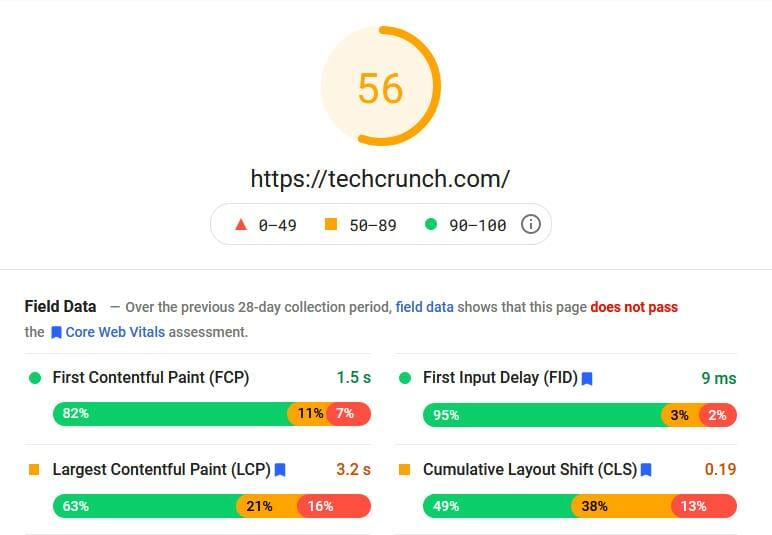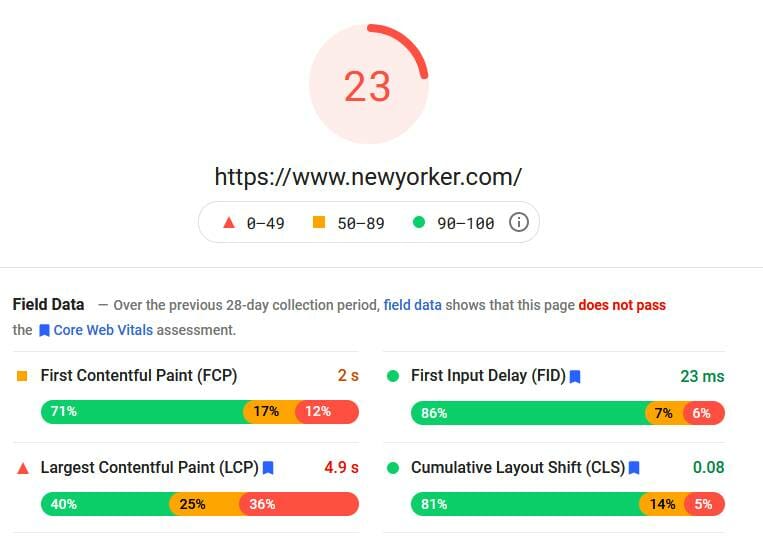Core Web Vitals may shake up rankings more than you realize.
Reputable organizations across the world rely on WordPress as the foundation for their top-ranking websites. These are serious, high-profile organizations with significant domain authority that register daily traffic in the millions.
But many of these organizations also have something else in common. Many of them fail Google’s new Core Web Vitals assessment. You’d be surprised which high-profile names have alarmingly low Core Web Vitals scores. Even Google subsidiary YouTube doesn’t pass the test.
We’re going to take a look at what this means for WordPress agency developers, and offer some guidance on what you can do to prepare your clients for success in a world where SEO rankings increasingly rely on Core Web Vitals.
Take a Close Look at the Numbers
Before explaining why these major properties are suffering low scores and interpreting what that means for WordPress agency developers, we need to look at the scores themselves. Here are some of the top-performing WordPress websites and their results from Google’s Page Speed Insights tool, as of July 2021:
- TechCrunch

TechCrunch regularly tops the list of high-traffic websites running on WordPress. It has excellent rankings and brings valuable tech news and commentary to millions of people every day.
With a desktop Core Web Vitals score of 56, TechCrunch is well behind what Google considers to be a successful score. The site’s main page loads FCP suitably quickly but performs poorly on LCP. This indicates that the site may need to better optimize its use of images.
TechCrunch’s FID of 9 milliseconds passes Google’s test, but the site has a large amount of unused JavaScript and an unhealthy amount of render-blocking resources. It also incorporates multiple page redirects into its code, which Google strictly penalizes.
When expanded to include the aggregate experience of all pages served from TechCrunch’s domain, the website still doesn’t pass the Core Web Vitals assessment. Its scores are roughly the same. Its mobile site earns a score of 19 overall – well below Google’s standards.
- The New Yorker

The New Yorker offers award-winning journalism to readers around the world. It brings political insight to millions of people with podcasts, photos, and documentaries about some of the day’s most pressing issues.
While the New Yorker’s articles continue to rank well, and its WordPress site offers an excellent user experience for visitors, the website nonetheless tests poorly for Google Core Web Vitals.
The New Yorker’s FID and CLS scores are good, indicating that the website runs quickly and smoothly. However, it suffers on account of its high-definition imagery. Properly sizing its images and preloading its largest ones would shave more than three seconds off those scores. The New Yorker’s total network payload is simply much larger than it needs to be.
When expanded to include all pages on the domain, the New Yorker’s CLS score worsens significantly. Only the FID score retains a pass across the entire desktop domain. On mobile, the website scores 18, with high scores for everything except the CLS score.
The New Yorker may need to revisit the way it hosts images and other large files in order to change these scores. As long as the website takes this long to present its largest files, its Core Web Vitals score will not improve.
- Bloomberg

Bloomberg serves millions of website visitors with accurate, up-to-date information about the world of finance. It serves visitors all around the world with a well-designed WordPress website that nonetheless fails on its CLS score.
At first glance, it looks like one of the main culprits behind Bloomberg’s poor CLS performance is its reliance on a slide-out notification pop-up right below the home page stock ticker. It greets every new visitor with a call-to-action encouraging visitors to enable notifications, pushing the rest of the home page’s content down a few lines in the process.
Interestingly, the home page’s FCP, LCP, and FID scores all pass. But when expanded to include all web pages served on Bloomberg’s domain, only FID manages to pass Google’s Core Web Vitals assessment.
- The Government of Sweden’s Mobile Website

Not all high-ranking websites are commercial enterprises. Millions of travelers, visitors, and citizens rely on Sweden’s official government website for guidance every day. Major search engines like Google tend to give government websites greater authority than their commercial counterparts.
Unlike every other website on this list, Sweden’s desktop site actually passes Google’s Core Web Vitals with a score of 98. It is by far one of the best-performing WordPress sites we’ve seen so far.
But the Swedish government’s mobile site leaves much to be desired. In terms of contentful paint execution, the website fails to deliver its largest elements quickly enough to guarantee a good score.
In order to maximize results, the Government of Sweden will need to resize its images and reduce the amount of unused JavaScript on its mobile site. It may also have an opportunity to optimize image formats to reduce contentful paint times.
- Quartz

Quartz is a content publisher that focuses on producing deeply insightful articles that help readers make better leadership decisions. It covers politics, economics, and science in an approachable, yet highly informed way.
Quartz is notably closer to a passing score than many other entrants on this list. The main thing holding Quartz back is its CLS. Google found inefficient cache policies for 29 on-site resources, which may cause the website to display certain elements out of order, increasing the flux of layout elements and worsening its score.
Quartz’ mobile website doesn’t fare better, suffering from many of the same problems but to a more severe extent. Improving the mobile website will require more time and resources than getting Quartz’ desktop site into the passing territory.
How to Improve Core Web Vitals Scores on WordPress
It might be tempting to believe that Core Web Vital assessments are simply prejudiced against WordPress – that’s not true. WordPress websites can score well on Core Web Vitals assessments if they benefit from compliant design and execution.
Achieving compliance isn’t always simple. Some websites need to be rebuilt from the ground up. Many of the changes that Google demands are structural in nature, requiring an entirely new web development approach. Passing the Core Web Vitals assessment often means much more than simply adjusting a few technical configurations.
Having a White Label WordPress Development agency on hand to help you achieve those tasks can be a valuable advantage. If your clients’ success depends on high search engine rankings, the ability to offload some of your most time-intensive tasks to a white label WordPress provider is a critical advantage you won’t want to give up.
